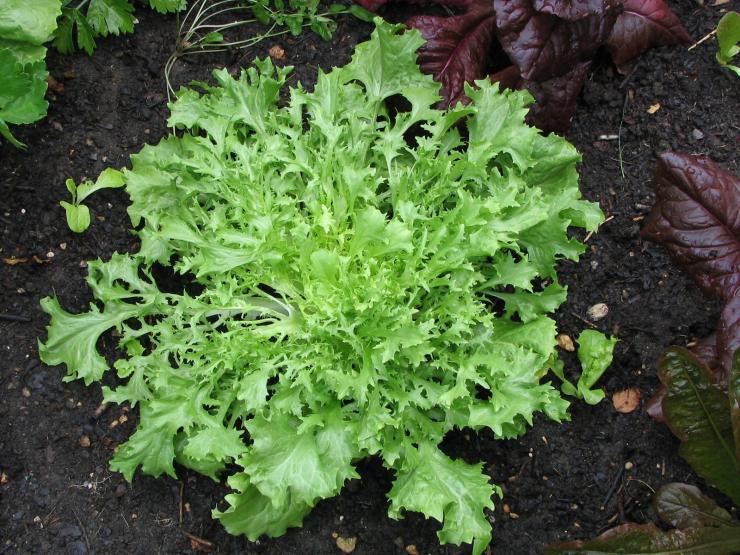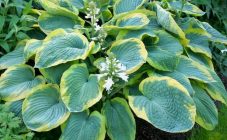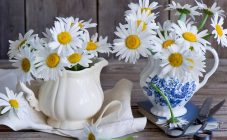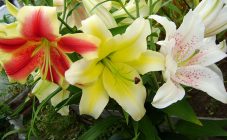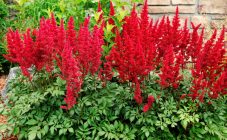Content:
Hydrangea is not one of the most frequent guests of Russian gardens. And in vain - the colors and the unusual shape will embellish and refine the summer cottage.
Description
Hydrangea belongs to flowering crops that belong to the Hortensia family. The family includes mainly perennial shrubs, as well as trees, sometimes reaching 3 m, and even lianas.
Evergreens grow in the subtropics. However, most of it has to do with the deciduous group.
Hydrangea blooms for almost six months: from May to the end of the autumn season. On the bush, inflorescences are formed in the form of a ball, panicle or shield. The color palette of the petals is striking in the variety of colors and depends on the variety and chemical composition of the soil:
- creamy white;
- raspberry;
- purple;
- pinkish blue;
- blue;
- peach.
Grows in America and Asia. Some varieties are found in the garden plots of the Moscow region, as well as in Siberia.
The name of the plant is based on the name of the sister of Prince of the Holy Empire Charles Henri de Nassau-Siegen - Hortense. In the land of the rising sun, the plant is called Ajisai. Translated means a flower that resembles a purple sun.
Hydrangea breeding techniques:
- seeds;
- dividing the bush;
- cuttings.
Types of hydrangeas that are undemanding to care for are in demand among summer residents:
- tree-like;
- paniculate;
- large-leaved.
Large-leaved hydrangea: varieties
In its natural environment, it grows on Sakhalin and Japan. The height of the varietal hydrangea is almost 2 m. A stunted hydrangea is grown in pots, which reaches 0.5 m.
The bush does not tolerate the winter well, the shoots become lignified in the second year. The culture doesn't like limestone. The intense green leaves have an oval or egg shape and a pointed tip.
The plant blooms at the height of summer. The dimensions of the flowers are up to 3 cm.
Recently, thanks to the efforts of breeders, large-leaved hydrangea has appeared with unique winter-hardy varieties that adapt to the conditions of the Urals and the middle Russian zone. Flowering occurs on the shoots of the current year. Freezing of plant branches is not a hindrance to the flowering of growing shoots.
Pros of a large-leaved flower
Advantages broadleaf hydrangea:
- variety of colors;
- tolerates cold winters;
- recovers quickly;
- immunity to harmful insects and diseases.
Winter hardy varieties
Hydrangea varieties that are winter hardiness appeared at the end of the 80s of the last century. A guest from North America easily tolerates -15 ° C, European species can withstand temperatures of -20 ° C.
Among hydrangeas are distinguished by remontant frost-resistant varieties:
- Blue Heaven;
- Firewox Pink;
- White Ball;
- Mini Penny;
- Red Sensation;
- Coco Blank;
- Romance;
- Endless Summer;
- Expression.
Hydrangea blue
This beautifully blooming bush is suitable for creating hedges, gazebos, garden paths.
There is no special type of blue hydrangea. The culture is called so because of the color of the flowers. The large-leaved hydrangea has bluish and blue inflorescences. Plants are grown in which flowers differ in 2 or 3 tones. Shades change during the growing season.
Among the blue frost-resistant hydrangeas are:
- Mini Penny. The repair hydrangea blooms on the shoots of this year. Distinctive features of the plant: juiciness of green leaves, delicate blueness of flowers that gather in spherical inflorescences.
- Ramars. Small compact bush. Belongs to the multi-colored varieties, which are typical purple, dark blue with white tint, purple flowers.
- Compeito. Hybrid. The color of large flowers is bluish-purple, with a white center.
- Perfection. The flowers are like a rose. Change the pink tone to a blue tint. Look great in a retinue of their own kind.
- Hopcorn Blue. The height of the shrub is 60-80 cm. Blue flowers are similar to a tulip. Flowering occurs on the branches of the second year.
Pink hydrangea
Hydrangea large-leaved varieties change color during the flowering period. Buying Rose hydrangea will pleasantly surprise you. If the rules of planting and caring for Rose are followed, the flowers will delight in blue.
This is the peculiarity of pink hydrangea and its varieties. Not all gardeners focus on this. The color of the hydrangea can be changed.
Popular broadleaf varieties
Especially appreciated by flower growers:
- Hydrangea Peppermint. The height of the Peppermint hydrangea is about 60 cm. It blooms on both last year and this year branches. Decorativeness falls in July and amazes with beautiful inflorescences.
The color of the flowers is pinkish with a white border. If the soil is acidic, the flowers are blue or purple with the same border. The glossy glow of the foliage sets off the beauty of the Peppermint hydrangea, its description will help gardeners make a choice in favor of the plant. - Spike. The fast growing bush is different with the beauty of ruffled deep pink, with a delicate crimson shade of flowers that conquer with corrugated petals. The culture grows up to 120 cm. The Spike hydrangea has rough green foliage and ball-shaped inflorescences up to 25 cm in diameter. It pleases with flowering from the middle of the summer season to September.
- Amsterdam. The shrub reaches 1.5 m in height. Hydrangea Amsterdam is one of the best red varieties. Distinctive features of the shape of the bush: density, branching, abundant flowering, which begins in the last decade of June and lasts until October.
- Sibylla. The height of the bush ranges from 100 to 200 cm. When grown in containers, the culture has miniature dimensions - 40-60 cm. The density of intense green leaves, lignification of last year's shoots are characteristic of Sibylla's hydrangea. 30 cm inflorescences change color from purple to raspberry.
Hydrangea paniculata
In appearance, panicle hydrangea looks like a small tree. The height of the culture in open areas near Moscow reaches 3 m. The variety has a dark green voluminous leaf, slightly pubescent at the top and strongly at the bottom. Its shape is oblong, ovoid or ellipsoidal.
Panicle hydrangea is characterized by the width of dense pyramidal inflorescences. A distinctive feature of the plant is the duration of flowering, which does not stop until frost. The species is cold-resistant due to the covering of shoots with bark by autumn.
Benefits of panicle hydrangea
Among the advantages of the plant are:
- will delight you with flowering for 3 or 4 years after planting;
- differs in frost resistance and immunity to phyto-diseases;
- in landscape design, they are cultivated as a bush or a small standard tree;
- when cut and dried, it is used as a dried flower;
- varietal and species diversity will appeal to gardeners.
Varietal hydrangea paniculata for the Moscow region
In the Moscow region, the following are considered the best varieties for growing hydrangeas.
Limelight
A tall shrub in the form of a ball with velvety foliage reaches 2 m. The dense inflorescences have a greenish color, which acquires a pinkish tone by the end of the season.
Phantom
A powerful, branched bush that grows up to 250 cm. Flowers with a milky-creamy shade turn pink as autumn approaches.
Vanilla Fraze
The two-meter bush has large-flowered conical inflorescences. The flowers are pink-red.
Pinky Winky
Shrub less than 2 m high. The openwork cone-shaped inflorescences are distinguished by their purple-pink color.
Great star
The distinctive variety is the merit of French breeders. In the panicle hydrangea, reaching 2 m, large flowers with long petals on thin branches resemble fluttering butterflies.
Grandiflora
2-meter shrub resistant to frost. Large hydrangea inflorescences differ in a pale pink tone.
Magical moonlight
Plants like partial shade and acidified soil. The inflorescences have a light lemon color.
Dwarf varieties
Among gardeners, dwarf panicle hydrangea is loved for the height and dimensions of the bush:
- Jane / Little Lime. The fruit of the work of American breeders. Bush 60-80 cm high. It is a mutation of the Limelight variety.
- Bobo. The height of the dwarf varietal hydrangea is 0.6-0.7 m, the diameter is 0.5 m. The cone-shaped inflorescences change their shade from whitish-lemon to pale pinkish color. It blooms violently in July and lasts until September. Ideal for mixborders, narrow flower beds, along trails.
- Bombshell. 100 cm undersized hydrangea with dark green leaves on strong branches and a massive round crown. Looks like the famous Bobo from Belgium (70 cm dwarf, with dense inflorescences).
- Little Quick Fire. In undersized hydrangea, early flowering begins. With the arrival of the summer season, the white flowers on the 80 cm bush become pink, and darken by the onset of autumn. Inflorescences turn red before other varieties bloom.
- Baby Lace. Shrub 1 m high and 80 cm in diameter. Hydrangea has strong stems, cone-shaped inflorescences. The lacy white flowers later become creamy. The dwarf blooms from mid-summer to September.
Hydrangea
They are called differently wild or smooth hydrangea. Gardeners are grown because of their unpretentious care. Due to its winter hardiness, it is appreciated in the personal plots of the central Russian strip. The height of the shrub is on average 250 cm. Branches are bare, erect. The foliage is lush, rounded. Flowers have different colors. The peak of decorativeness comes in June and pleases until September.
Tree hydrangea
Popular varieties
Treelike varieties of hydrangea that summer residents recognize:
- Sterilis;
- Annabelle;
- Invincibelle Spirit;
- Hayes Starburst;
- Incrediball.
Pros of tree hydrangea
The benefits of a tree culture include:
- dissolution of flowers in the first year after planting;
- luxurious bloom for 3 months;
- flower garden decoration;
- survival of cuttings.
Agricultural Secrets
Hydrangeas put forward almost the same requirements for growing conditions. When growing hydrangeas, emphasis is placed on:
- Watering: Plants love moist soil. Regular irrigation prevents the soil from drying out. An adult shrub is watered twice in a drought, spending up to 40 liters, 20 liters are enough for a young specimen. Large-leaved hydrangea suffers most from over-dried soil.
- Mulching. To maintain soil moisture, the soil under the bush is mulched:
- sawdust;
- humus;
- straw;
- coniferous butcher.
- The growth and development of hydrangeas determines the type of soil, preferably loam with a pH of 6-7. Avoid adding manure to the soil and adding lime to the planting hole.
- A sunlit or shady flower bed, as well as drafts, are not quite suitable for a hydrangea planting site. Penumbra to the liking of the bushes. The most light-loving culture is the panicle hydrangea.
- Shrubs are pruned in early spring or at the end of winter, starting at 4 years of age. In the bush, up to 12 strong shoots are left, which are shortened by 30-40 cm. Cut branches are suitable for cuttings. The operation improves the immune system of the panicle hydrangea, causes the development of branches and the splendor of the bush.
- Hydrangea blooms luxuriously if mineral feed is added twice a month, organic matter - 1 time.
Feeding crops begins in the spring and ends in the height of the summer season:
- before adding mulch, a complex fertilizer is used, Kemira flower is in demand, it is sprinkled around the bush;
- in the bud stage, they are fed with phosphorus and potassium 50 g each and potassium sulfate (25 g);
- beware of frequent nitrogen application - it affects the shade of flowers, hydrangea does not cope well with wintering;
- feeding plants with whey or kefir with soaked bread is suitable.
Pest and phyto-disease control
If spider mites and aphids are bothering you, use insecticides:
- Kleschevit and Tiofos;
- Aktara and Fufanon.
In case of damage by chlorosis, iron-containing preparations are added during irrigation.
How to survive the winter without losses
However, despite the assurances of breeders and sellers in the cold resistance of plants, the bush needs to be covered with the onset of winter.
For hydrangea to winter well, it is important:
- Spud shrubs before the approach of frost, pour a couple of buckets of soil into the root zone of the hydrangea.
- Place low wooden boxes near the bush.
- Place plant shoots on the boxes and attach to the soil through the holes in the boxes.
- Wrap the hydrangeas with non-woven fabric several times, on top with plastic wrap.
- Reinforce the shelter with bricks or stones from gusts of wind.
The variety of hydrangeas will allow gardeners to make a worthy choice. Which varieties to choose and how to plant is a matter of personal taste.












